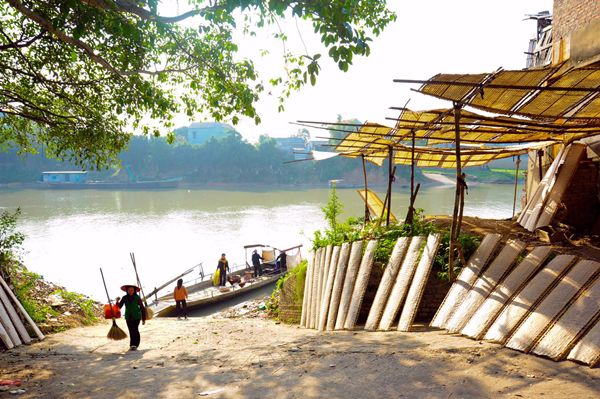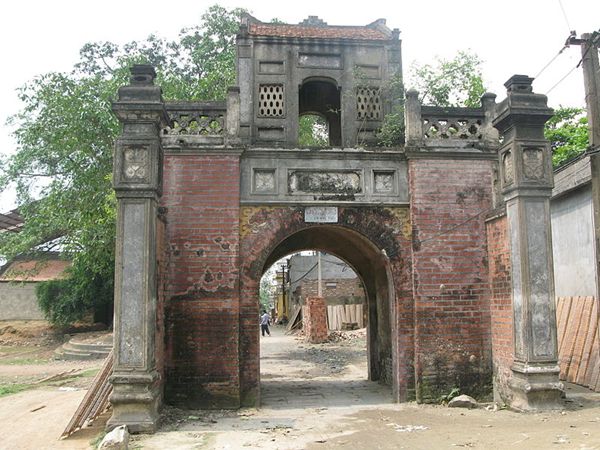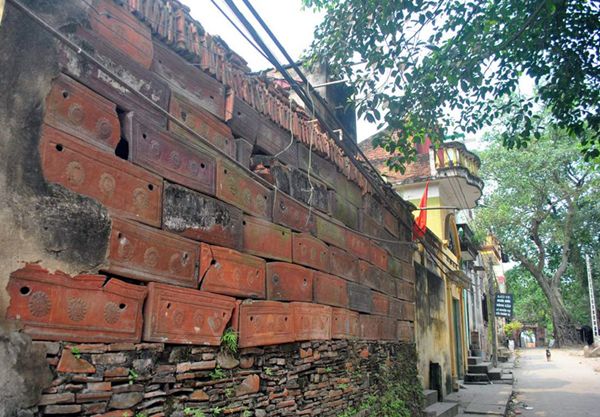A village with a unique way of building houses
In many other rural areas, cottages with mud walls were the only option during times of economic hardship, but in Tho Ha, once known as one of three major northern ceramic centers, along with Bat Trang and Phu Lang, there was always a plentiful supply of reject tieu sanh lying around which local people could use to build their houses. Today the tieu sanh houses are regarded as one of the most unique types of architecture in Vietnam.
The tieu sanh used were approximately 40cm x 20cm wide and completely hollow inside, with two ventilation holes. Decorated on the outside with simple patterns, they were used in place of bricks, stacked on top of each other with only mud from the riverbed to serve as mortar. Nonetheless, having stood for hundreds of years, the houses here are still very solid. To learn about the ancient tieu sanh houses, we went to meet the family of 83-year-old Nguyen Cong Duoc, whose house was built about 300 years ago and is said to be the oldest in the village.
Mr. Duoc can remember Tho Ha when it was still a thriving pottery village and he says that he feels very sad that the Tho Ha ceramics industry died out. “I lived with pottery from when I was very small, but suddenly everyone quit,” said Mr. Duoc. “I know that the times have changed but I can’t help feeling sad about what we’ve lost.” For him and other elderly people in the village, the surviving tieu sanh houses are not only historic treasures left by their ancestors but also a testament to a bygone golden age.
“In times gone by Tho Ha was famous for such products as steamers, jars, and especially tieu sanh,” said Mr. Duoc. “At one time tieu sanh were made all over the village. But broken or defective tieu sanh were never thrown away, they were always recycled and used in place of bricks to build houses.”
All Tho Ha ceramic items were known for their high quality and it is said that they would last for thousands of years without losing their colour, thanks to the fine quality of the local clay and the special firing techniques used.
After being shaped and dried, unglazed tieu sanh were fired at a high temperature to create dark brown earthenware with a characteristic hard surface which rang lightly when struck, had sharp edges and, thanks to the high firing temperature, was completely waterproof and not susceptible to mould.
Mr. Duoc told us that since Tho Ha was located right next to the Cau River, it always suffered from flooding during the rainy season. Therefore, building houses from tieu sanh was particularly suitable. The tieu sanh walls were thick and floodwater could not penetrate them, so there was never any danger of the floor subsiding.
Pointing towards the tieu sanh walls of his house, Mr. Duoc said, “My house was built five generations ago. Thesetieu sanh walls are equally effective in summer and winter time. On cold days the interior stays warm while on hot days it stays cool. I truly believe that these walls could last for a thousand years.”

They were not expensive to produce, neither were they decorated with sophisticated patterns, but the tieu sanhn one the less gave rise to a unique type of residential architecture. Packed closely together in the traditional rang bua(harrow tooth) style, the tieu sanh houses of Tho Ha with their red walls and curved gates create an ancient space which resembles parts of the Old Quarter in Hanoi.
Another older resident, 94-year-old Mr. Nguyen Ba Lam who lives in Hamlet 1 of Tho Ha village, is the only one whose tieu sanh house still incorporates a 30m long ancient wall.
His house is still in excellent shape and has shown no cracks or other damage over a period of nearly three centuries. “Mine is the sixth generation to live in this house,” he tells us animatedly. “The roof has been repaired on several occasions, but up to now the walls have remained intact. I just hope that my descendants can continue to preserve this house. It is a gift from our ancestors.”
The ancient houses are considered a symbol of a glorious past when the entire village made ceramics all year round. Its high-quality products brought prosperity to local people for hundreds of years.
Like others who are deeply attached to this ancient pottery village, Mr. Duoc feels sad when local people demolish their tieu sanh houses. He often wanders around the village checking the status of the ones which remain. “It’s so sad,” he sighs. “So many tieu sanh houses have already been replaced by taller and more modern buildings.”
Mr. Duoc took us to his old workshop to show us about 10 tieu sanh which he himself made, many decades ago. “I still keep a few to remind myself of those times, you can see that they are all of high quality.” Then he strikes each one with his hand, generating the characteristic ringing sound.
Later we went to meet the family of Mr. Nguyen Ba Trong, who recently demolished his old tieu sanh house to make way for a brand new two-storey residence. His new house was almost complete, but it seemed that few members of his family were happy with the change, least of all Mr. Trong’s elderly father.
Mr. Trong explained their dilemma, “It’s very sad that we had to replace the old house with a modern one. But we had no choice. The size of our family has increased and we need more space for living as well as a space for drying banh da (dry rice pancakes).”

Despite their advanced years, the surviving tieu sanh houses in Tho Ha village have preserved their colour and the decorative pottery shards are still as bright as the day they were fixed in place on the walls. The old walls also remain very strong. You can see all the old walls in your north Vietnam tours.
Recently, when one of the old houses was demolished, the construction workers took a long time to break down the tieu sanh walls because of their strength.
According to Mr. Trong, the reason why old houses in the village continue to be demolished is that many villagers are now involved in the production of banh da and the ancient houses have very little space for drying them. “In the past almost all of house walls in the village were made with tieu sanh, but now only around 60 walls remain,” he told us. Many things changed. However, there is something remained the ancient beauty. Choosing Ha Tho village destination is surely one of the best choices for your Vietnam Discovery Tours.
In the evening, as the ancient tieu sanh houses cast their shadows onto the tranquil Cau River, Mr. Duoc walks with a heavy heart through the alleyways, checking each and every old house for signs of new development. “Who will still remember Tho Ha and its golden age of ceramic production when all those old houses have gone?” he sighs.
Start planning your tailor-made Vietnam tour by contacting one of our specialists…









